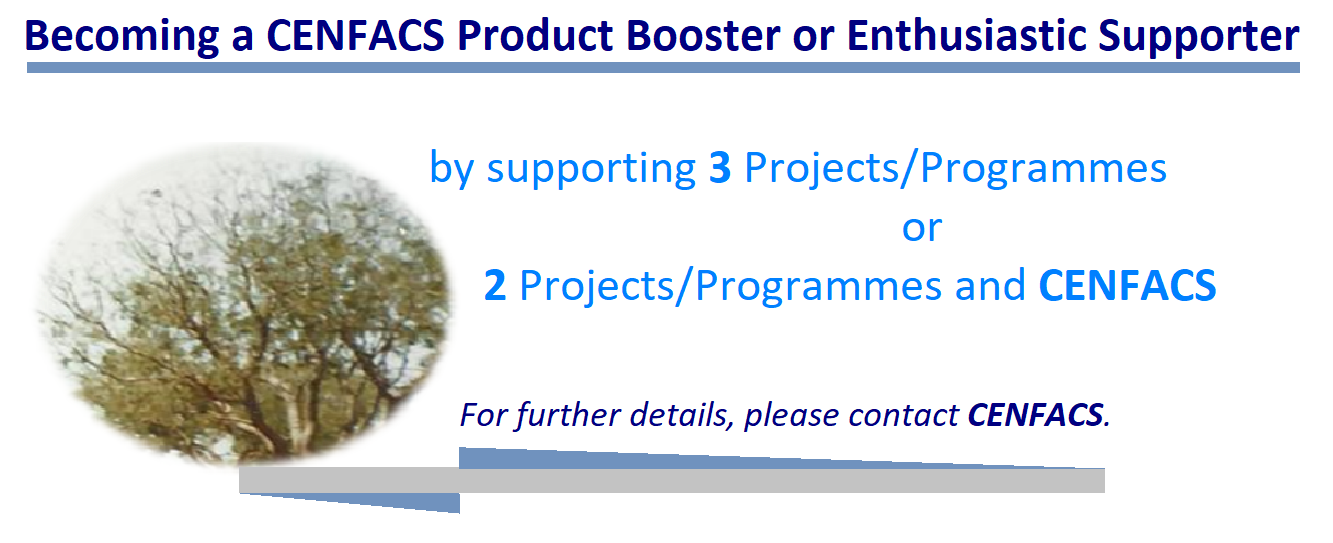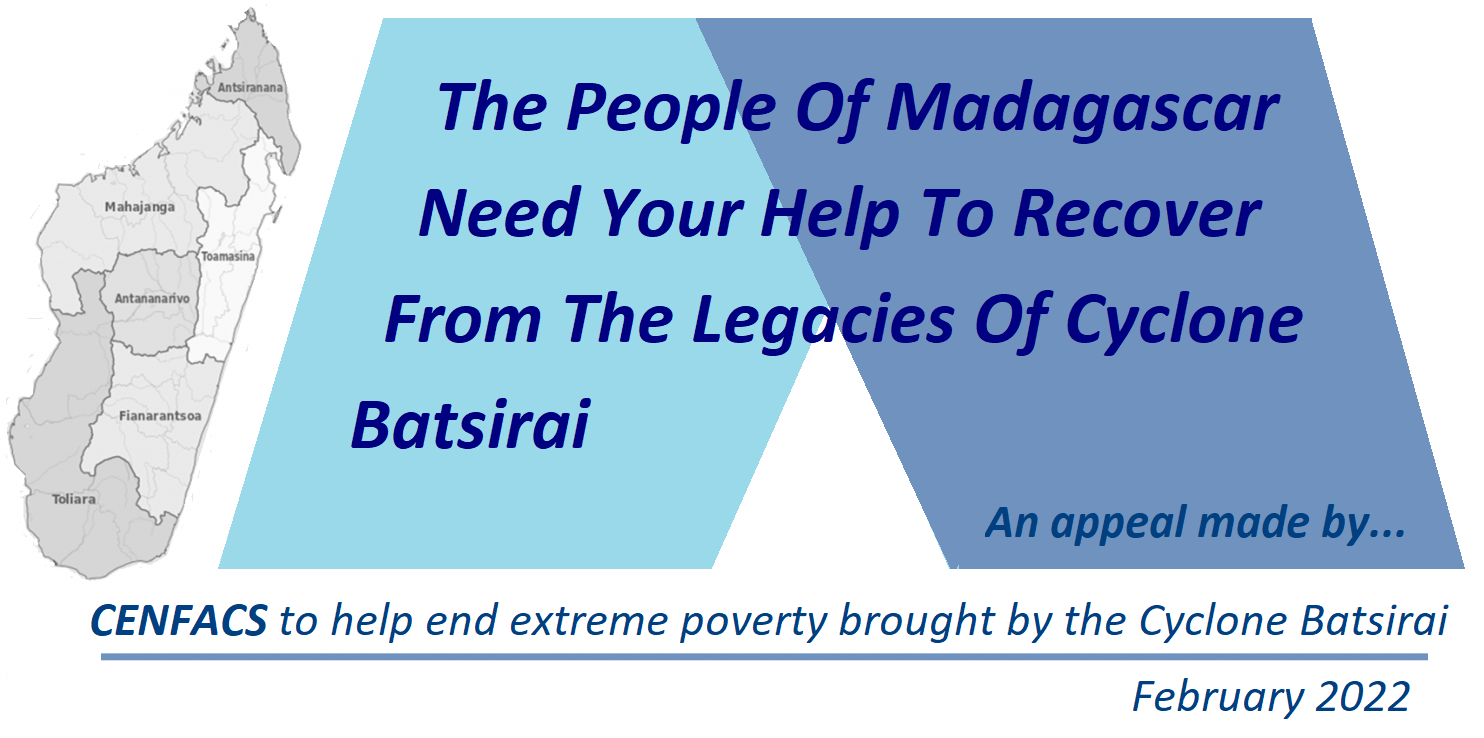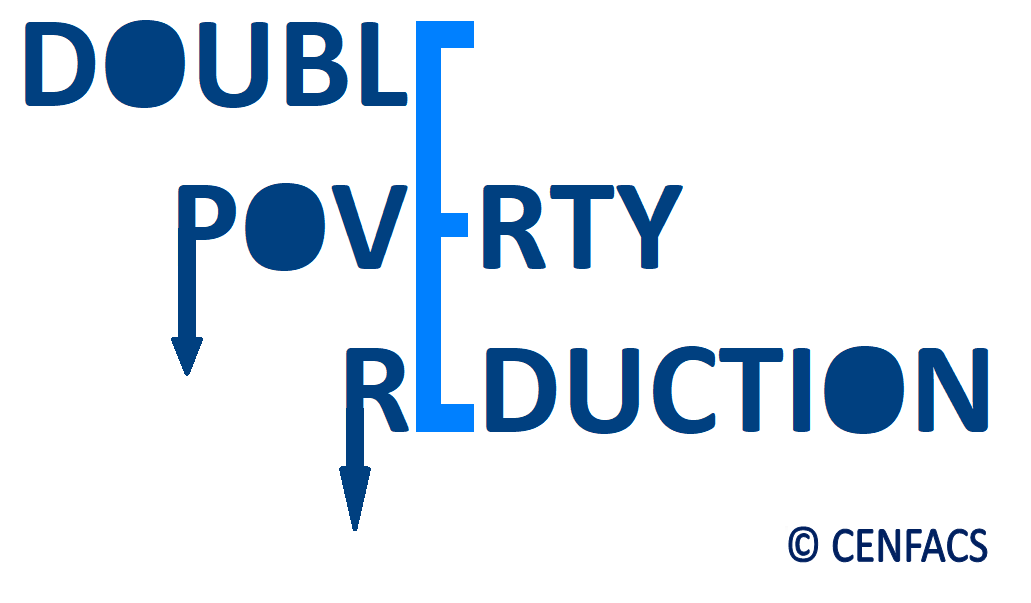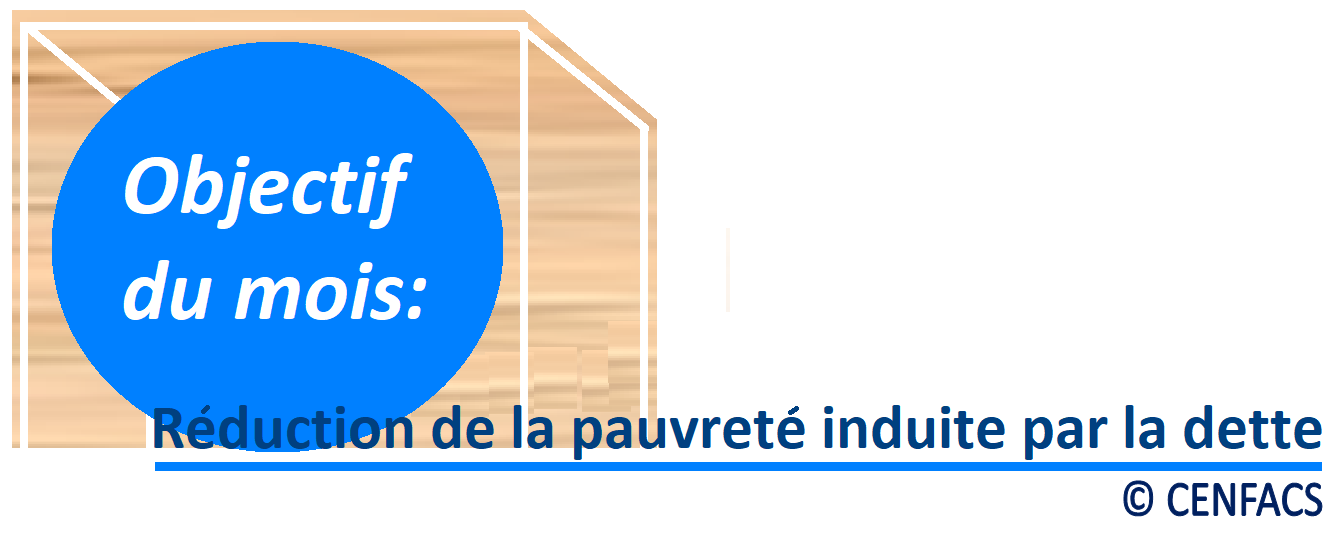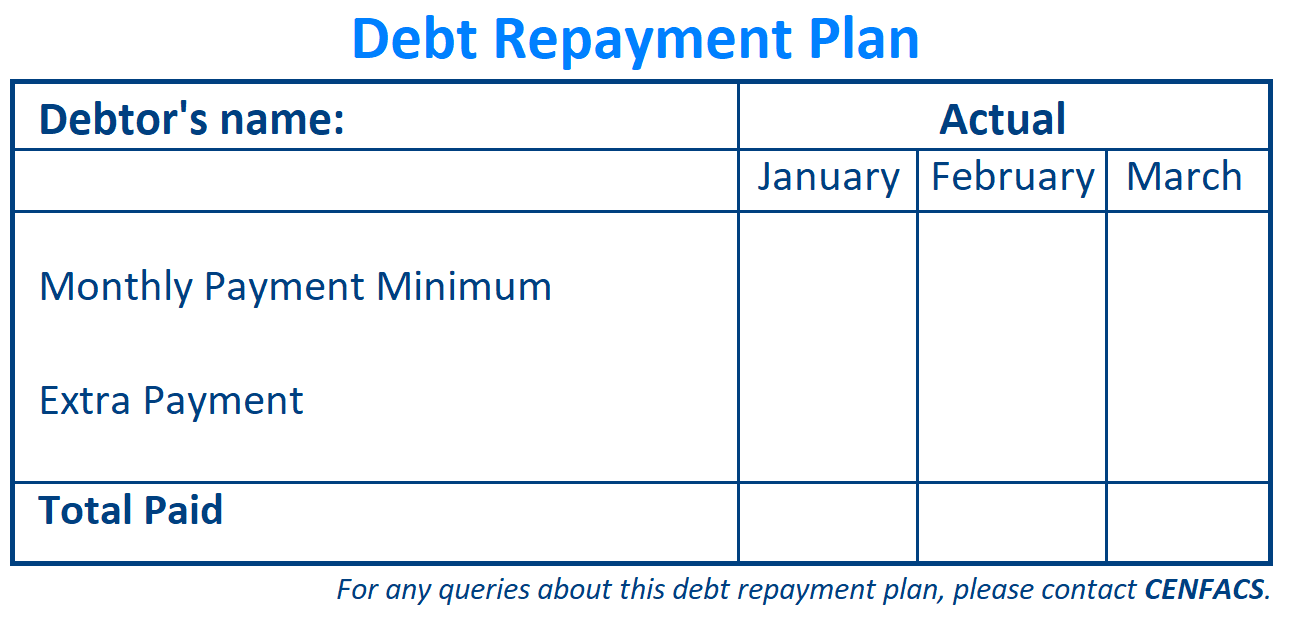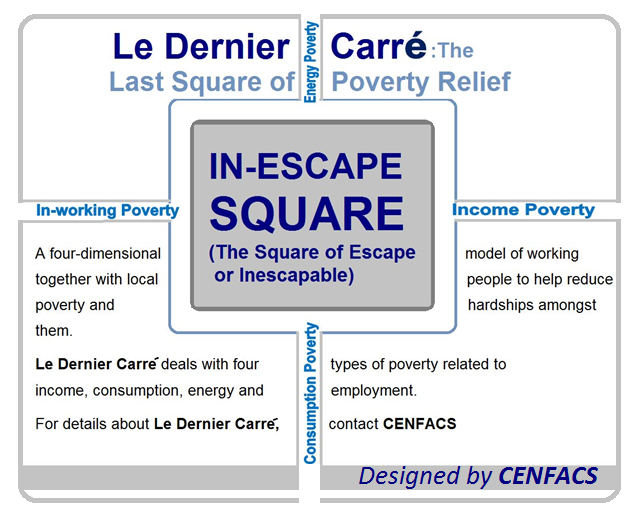Welcome to CENFACS’ Online Diary!
16 February 2022
Post No. 235
The Week’s Contents
• Debt Restructuring for the Highly Indebted Poor Households
• The Cyclone-stricken People of Madagascar Desperately Need your Help at Present
• Review of 2021 Peace Appeal for Ituri Region of the North-eastern Democratic Republic of Congo
… And much more!
Key Messages
• Third Wednesday (16/02/2022), In Focus: Debt Restructuring for the Highly Indebted Poor Households
Our Month of Sustainable Development continues with the sub-theme of Debt Restructuring for the Highly Indebted Poor Households.
Debt Restructuring for the Highly Indebted Poor Countries (HIPHs) is part of the United Nations (1) Sustainable Development Goal 17 and Target 4 for poor countries.
Debt restructuring matters not only for countries but also for households and individuals making indebted countries. It is not surprising if Mohamed M. Malik and Peter Holmes à Court (2) argue that
“Without rapid debt restructuring and relief, half a billion dollars flows every week from the continent [Africa] to service lenders money that is desperately needed by vulnerable households and children”.
Debt restructuring can be debtor-friendly so that debt does not cause enormous pain to the already suffering highly indebted poor households. In particular, debt restructuring should not be done in a way that threatens the coverage of inescapable family/household specific costs.
Therefore, the key message here is debt restructuring should not compromise the ability of HIPHs to meet their inescapable specific costs. The notion of inescapable family-specific costs stems from the Social Metrics Commission (3) when it defined the total resources available. Failure to respect this notion in the process of restructuring debts can further damages the lives of HIPHs and eventually push them into persistent and deep poverty.
To get the most of this first message, please read under the Main Development section of this post.
• The Cyclone-stricken People of Madagascar Desperately Need your Help at Present
The People of Madagascar need your support to recover from the legacies of the cyclone Batsirai.
According to the local sources in Madagascar, since the cyclone impacted nearly ten days of ago in the coast of Madagascar and the region of Fianarantsoa, it has left the following after-effects:
∝ Almost 92 LIVES have been TAKEN
∝ 1,200 CLASSROOMS have been DESTROYED putting nearly 112,000 CHILDREN at risk of DE-SCHOOLING
∝ More than 60,000 PERSONS have been DISPLAYED
∝ There is a HUGE FOOD CRISIS
∝ Two TOWNS were STRICKEN by the disaster (which are: Manakara and Mananjary)
∝ There is an ENORMOUS LACK OF ACCESS to safe drinking water
∝ Between 300,000 and 400,000 PEOPLE are WITHOUT access to healthcare
Etc.
Before even the cyclone Batisrai stroke, it is known that Madagascar is suffering from the following:
∝ More than ONE MILLION people in Le Grand Sud of Madagascar rely on international food aid
∝ The country has experienced TWO-YEAR drought
∝ ONLY 3% of people are vaccinated against SARS-CoV-2 in Madagascar.
Additionally, it emerges from the findings of the outlook jointly carried out by the the World Food Programme and the Food and Agriculture Organisation of the United Nations (4) that
“Madagascar continues to remain a hunger hotspot due to persisting high levels of acute food insecurity (that is; any manifestation of food deprivation that threatens lives or livelihoods regardless of the causes, context or duration” (p. 13)
Because of the above mentioned after-effects and the existing food deprivation in Madagascar, particularly in the areas severely hit by the cyclone Batsirai; the need for emergency support is even greater than ever before.
There are organisations (like United Nations Children’s Fund, World Food Programme and others) that are already on the ground and trying to help as much as they can. However, because of the scale and severity of the Batsirai shock there is a need to complement these efforts.
The demand for items such as emergency medical products, accommodation tents, water purification equipment and food stuffs is 5 times greater than before the cyclone Batsirai stroke.
They need life-saving and sustaining services restored as the few basic infrastructures have been destroyed by the power of the cyclone.
You can help the Cyclone-hit People of Madagascar to recover from this calamitous natural disaster.
Would consider making a gift to help the Cyclone-stricken People of Madagascar to navigate their way out of this crisis?
You can donate, gift aid and or support differently by
phoning, e-mailing, texting CENFACS and filling the contact form on this website.
Please support today so that we can help the struggling Cyclone-hit People of Madagascar to navigate their way out the destructive effects of this environmental disaster.
To discuss and get further details about this appeal, please contact CENFACS at http://cenfacs.org.uk/contact-us/
Thank you for considering delivering on this appeal.
• Review of 2021 Peace Appeal for Ituri Region of the North-eastern Democratic Republic of Congo
In February 2021, we launched an appeal to support innocent peoples (that is, women, men and children) who were suffering from a deadly conflict between the agriculturalist Lendu and pastoralist Hema ethnic groups in the Ituri region of the North-eastern Democratic Republic of Congo.
One year on since then, we are reviewing this appeal to assess if the goal of ending situational poverty created by this deadly conflict and objectives of this appeal have been reached. In particular, we are assessing if the following objectives have been met:
√ Saving lives of displayed women, men and children
√ Stopping the creation of favourable conditions for the spread of infections like COVID-19
√ Restoring destroyed basic infrastructures (e.g. homes, fields, livestocks, health centres, etc.)
√ Preventing human rights violations
Etc.
We are as well doing this review since the Food and Agriculture Organisation of the United Nations and the World Food Programme (op. cit.) jointly argue in their findings that
“The protracted food crisis in the Democratic Republic of Congo – country already 5.4 million projected in Emergency (Integrated Food Security Phase Classification 4) nationwide for the January to June 2022 period – will likely be a deterioration. This is expected to be the consequence of further intensification of violence in the Eastern province and the secondary impact of a fourth wave of COVID-19, potentially leading to restrictions by neighbouring countries that will affect trade and other livelihood activities” (p. 14).
The review, which is a post-appeal needs assessment, will help us to determine if there is still urgent and pressing humanitarian needs that require another appeal. The review will as well contribute to find out what has been done so far and what gaps need to be filled in our collaborative work with the locals and their organisations.
To find out about this review and to add your inputs in terms of what has been done since we launched our first appeal, please contact CENFACS.
Extra Messages
• African Children’s Climate and Sustainable Development Goals (Generation Global Goals Project): Generational Impact Analysis of COVID-19 and its Variants on Children
Third round work about the generational effects of COVID-19 and its variants on children regarding the realisation of Sustainable Development Goals (SDGs)
It is fair to argue that COVID-19 has left and will leave some scars and fractures in the realisation of SDGs, particularly but not exclusively for those aspects of these goals relating to children. The study on the following five selected SDGs will help to speculate on how COVID-19 is impacting or can impact the realisation of SDGs for children (particularly but not exclusively African children).
• • Summaries of possible generational effects of COVID-19 and its variants on children regarding the realisation of SDGs
Let us broadly consider the five selected goals (Goal 13 to 17) out of 17 United Nations SDGs for dealing with the COVID-19 effects.
Goal 13: Take urgent action to combat climate change and its impacts
Although climate advocates called for urgent climate action during the COP26 at the 2021 Glasgow Summit, there is a need to recognise that COVID-19 did slow climate action in many parts of the world. This slowing down can only have some impacts on children and future generations.
Besides that, there is still the goal of mobilising funds under the Green Climate Funds which needs to be met. One could hope that these funds will reach poor children, victims of climate adversity. One could expect as well that climate action will be at a faster pace like during the pre-COVID-19 period.
Goal 14: Conserve and sustainably use the oceans, seas and marine resources for sustainable development
The increase of plastic waste linked to COVID-19 items (such as gloves, masks, sanitizing plastic bottles, etc.) in the seas and oceans as well as the threat they pose to marine resources is just one of the many revelations about how COVID-19 and its variants could directly or indirectly impact children and future generations.
Actions against the threats to the ocean under the One Ocean Summit (5) recently held in Brest (France) are welcome, However, the world is still struggling to conserve and sustainably use the oceans, seas and marine resources for sustainable development of children.
Goal 15: Protect, restore and promote sustainable use of terrestrial ecosystems, sustainably manage forests, combat desertification, and halt and reverse land degradation and halt biodiversity loss
COVID-19 and associated lockdowns may have halted some industrial activities, especially non essential ones. However, natural events such as drought, floods, landslides, etc. are still occurring.
For example, drought in the Horn of Africa has affected the availability of food and water for both humans and other beings (flora and fauna). Likewise, deforestation is still happening even if it is at low pace; just as the loss of biodiversity has not yet stopped. What does this mean for children?
It means threat to the ability of children and the generations to come to meet their own needs.
Goal 16: Promote peaceful and inclusive societies for sustainable development, provide access to justice for all and build effective, accountable and inclusive institutions at all levels
The Food and Agriculture Organisation of the United Nations and the World Food Programme (op. cit.) argue that
“In the Central African Republic, Central Sahel, the eastern provinces of the Democratic Republic of the Congo, northern Ethiopia, northern Nigeria, northern Mozambique, Myanmar, the Sudan, South Sudan and Yemen, conflict or organized violence remain key drivers of acute food insecurity. Violence has reduced people’s access to, and the availability of food by displacing populations, limiting their access to agricultural land and other livelihoods, and disrupting commercial trade and services and markets”.
From the above statement, it is possible to argue that peace, inclusive societies and access to justice are still a matter of dispute for the people living these areas of Africa. Children in these parts of Africa are also the victims of the lack of peace, inclusivity and justice.
Goal 17: Strengthen the means of implementation and revitalize the global partnership for sustainable development
The COVID-19 and associated effects have negatively impacted the partnership for sustainable development as the means to keep this partnership during the global lockdowns was only via information and communication technologies (ICT) and digital infrastructures. Yet, there is an ICT and digital divide between regions of the world, between the wealthiest and the poorest.
The majority of poor African children did not or do not have enough ICT and digital facilities to maintain and strengthen this partnership. So, there is still long way to see this partnership to be better implemented and revitalised.
We hope that the above summaries will provide some ideas about the generational impact analysis of COVID-19 and its variants on children, particularly but not exclusively on African children.
For those who would like to know more about our findings from this third round work and the stories of poverty reduction happening in Africa from CENFACS’ Africa-based Sister Organisations working with children, they should not hesitate to contact CENFACS.
• Project Planning Service for the Users of Triple Value Initiatives (or All Year-round Projects)
Following last week’s announcement regarding the start-up of Triple Value Initiatives (made of Run, Play and Vote projects), our project planning service is now available for those who would like to engage with either of these projects.
For those who are interested in this service, they can contact CENFACS by phoning, texting, e-mailing and completing the contact form on this website. We can together discuss in detail your proposals about either your Run or Play or Vote projects.
• Simultaneous Reduction of Debt-induced Poverty and Poverty linked to the Lack of Progress in the Realisation of Sustainable Development Goals
Debt-induced poverty can have several effects on highly indebted poor people and households. One of these effects is it could significantly delay or slow the progress about the realisation of sustainable development goals for the highly indebted poor households.
As part of the Month of Sustainable Development, we are looking at ways of simultaneously reducing both debt-induced poverty and poverty linked to the lack of progress in the realisation of sustainable development goals. We are doing in exploring ways of having initiatives that tackle the two issues.
For example, let us take the case of energy debt-induced poverty. If energy debt-induced poverty reaches a certain proportion or level, the United Nations Sustainable Development Goal 7 of ensuring access to affordable, reliable, sustainable and modern energy for all may be off track for the energy indebted poor. To avoid this to happen, both energy debt-induced poverty and poverty linked to the lack of progress regarding this Goal 7 need to be addressed.
So, this week we would be working with the community on ways of addressing both debt-induced poverty and poverty associated with the lack of progress towards the realisation of sustainable development goals.
Those who may be interested in this area of work and would like to be part of it or need to enquire about it, they are free to contact CENFACS.
Nous continuons à travailler sur l’Agenda de développement et le Programme de réduction de la pauvreté des années vingt-vingt (années 2020).
Dans le cadre de notre travail sur cet agenda et ce programme, nous sélectionnons chaque mois un objectif particulier de réduction de la pauvreté sur lequel nous concentrer.
Cette sélection peut provenir de l’un des objectifs déclarés de l’Agenda de développement et du Programme de réduction de la pauvreté des années 2020 ou en dehors de ces objectifs déclarés.
Pour ce mois de février 2022, nous avons sélectionné la Réduction de la pauvreté induite par la dette. Qu’est-ce que la réduction de la pauvreté induite par la dette? Qu’est-ce que sa sélection ou son orientation implique?
Comprendre la réduction de la pauvreté induite par la dette
La réduction de la pauvreté induite par la dette est toute mesure ou initiative prise pour réduire l’état, causé par la dette, de ne pas avoir d’argent et pas de biens matériels ou d’en avoir très peu.
En bref, il s’agit d’abaisser l’état de manque de revenu minimum pour acheter les besoins fondamentaux de la vie; état causé ou exacerbé par l’état de devoir quelque chose.
Implications pour la sélection de l’objectif du mois
Après avoir sélectionné l’objectif du mois, nous concentrons notre travail et notre état d’esprit sur l’objectif sélectionné en nous assurant que dans notre vie réelle et quotidienne, nous l’appliquons. Nous attendons également de nos sympathisants qu’ils travaillent sur le même objectif en soutenant ceux qui peuvent souffrir du type de pauvreté lié à l’objectif pour le mois dont nous parlons au cours du mois donné.
Pour plus de détails sur l’objectif du mois et sa procédure de sélection, veuillez contacter le CENFACS.
Main Development
• Third Wednesday (16/02/2022), In Focus: Debt Restructuring for the Highly Indebted Poor Households
In order to deal with the issue of Debt Restructuring for the Highly Indebted Poor Households, we have organised the following notes:
the notion of debt restructuring, causes of debt restructuring, approaches to debt restructuring, debt restructuring techniques, household debt restructuring and poverty reduction, debt restructuring and inescapable household-specific costs, political economy of the renegotiation and agreement of debt restructuring, and how CENFACS can work with the community on debt restructuring matter.
• • The notion of debt restructuring
The notion of debt restructuring here will be put in the context of individuals or households as we are dealing with households. As a result, we are referring to its definition as given by the online dictionary ‘financial-dictionary.thefreedictionary.com’ (6) which states that
“Debt restructuring is the process of a person or business negotiating and agreeing with its creditors to reduce its debt or to revise a repayment plan”.
Basically, debt restructuring is a debt reduction with an extension to the repayment plan or programme. The reduction could be about the amount of principal or interest or both. Debt restructurings can be informal, formal, enhanced and hybrid.
Because the above mentioned definition includes negotiation and agreement between debtor and creditor, we are going to come back on these two elements (negotiation and agreement) below when we will explain the political economy of the renegotiation and agreement of debt restructuring.
• • Causes of debt restructuring
Debt restructuring can stem from various sources. Among the causes, it is worth mentioning the following:
the evolution of debt structure over time, mismatch of debt and assets during the life time of debt, debt given on a wrong product or informational basis (e.g. mis-sold credits), misalignment between debt and cash flows, early repayments, etc.
HIPHs can come across these causes that could form the basis for debt restructuring.
• • Approaches to debt restructuring
To restructure debts, there are many approaches, which basically include two solutions:
a) market-driven solutions
b) government approach, which can be government-sponsored debt restructuring programme and/or legal/institutional framework.
The purpose of us highlighting these approaches is not to elaborate on them. Instead, it is about CENFACS working with the community members and helping them to understand how these approaches work and find out how helpful and supportive they can be in dealing with debt restructuring that these members may face.
• • Debt restructuring techniques
Principally, there are two techniques to restructure debt, which are: settlement and modifications of the terms of debt agreement.
a) Settlement
Concerning settlement, HIPHs cannot settle their debts or convert them into equity because they do not have the means to do it.
b) Modifications of the terms of debt agreement
Regarding modifications of the terms of debt agreement, they can include: interest rate, extension of maturity date, reduction of the face amount, reduction of accrued interest, etc.
In the context of the work between CENFACS and the community members, the focus will be on the aspects of modifications of the terms of debt agreement and how they can or cannot meet them.
• • Household debt restructuring and poverty reduction
Poor people and households may not be able to pay their debts. This is why it makes sense to look at the connections between household debt restructuring and poverty reduction. To look at the relationship between the two, we are going to refer to social and economic metrics of weekly total resources available, particularly the metrics of inescapable family-specific costs, as provided by the Social Metrics Commission (op. cit.).
• • • The metrics of inescapable family-specific costs
According to the Social Metrics Commission (op. cit.), this metrics includes:
“recurring housing costs, childcare costs, extra cost of disability, social care costs, others [other costs] that require more research/might apply in different
countries (e.g. travel-to-work, energy, healthcare)” (p. 20).
Any sensible household debt restructuring policy or plan needs to take into account this metrics. In practical parlance, the given policy or plan would consider the cost of living.
For example, the cost of living calculator or index produced by Expatistan (7) gives an estimation in terms of the summary of cost of living in the United Kingdom. As calculated by Expatistan, the estimated monthly costs for the family of four in the UK would be £3,570.
Therefore, our argument/key message is that household debt restructuring must take into account the reduction of poverty of the given indebted poor household. In other words, household debt restructuring should not threaten or destroy the ability or capacity of the HIPH to cover their inescapable specific costs. Otherwise, debt restructuring can lead to persistent and deep poverty, not to poverty reduction.
• • Political economy of the renegotiation and agreement of debt restructurings
The economist Jean-Baptiste Say (8) defined political economy as
“The manner in which wealth is produced, distributed, and consumed. Wealth, nevertheless, is essentially independent of political organization”.
It is also the search for ways to enrich a nation as Adam Smith (9) argued in his treatise on economic development, his Wealth of Nations in 1776.
By understanding the role of negotiation in political economy, HIPHs and their advocates can use their negotiating skills and bargaining power, however limited, to ensure that the problem of poverty reduction is at the heart of debt restructuring negotiations and agreements, but not on the periphery. This is important since debt restructuring reflects on the problematics of wealth creation for some and poverty creation for others.
In every negotiation and agreement, there is what is to be gained and what is to be lost; similarly, there are compromises to be made between the negotiating and agreeing parties. This can make debt restructuring a zero-sum game. What could be difficult to understand is that in debt negotiations and agreement poverty reduction is often marginalised or simply forgotten, especially when talking about HIPHs.
• • How CENFACS can work with the community on debt restructuring matter
Our work with the community on debt restructuring matter is about checking if the debtor has reached The Square of Escape or Inescapable from poverty. What is the Square of Escape or Inescapable from poverty?
• • • Le Dernier Carré Model or the Last Square of Poverty Relief or the Square of Escape and Inescapable from poverty
It is CENFACS’ a four-dimensional model of working together with local people to help reduce amongst them four types of poverty respectively related to elements: income, consumption, energy and employment. Through this theoretical model, it is possible to know if an individual has reached the four types of poverty, which are: income poverty, consumption poverty, energy poverty and in-working poverty. In order to do that, we use the appropriate metrics relating to each of these types as follows.
For income poverty, we would use income-based measure of income poverty like the total resources available as defined by the Social Metrics Commission (op. cit.)
Regarding consumption poverty, we shall call to food poverty line, which is defined by ‘devinit.org’ (10) as “the cost of a basket of food with minimum recommended nutritional intake”. This metrics can be used to quantify consumption poverty.
Concerning energy poverty, we shall turn to energy poverty line, which is “the sensitivity of the energy to household income as an indicator to identify the energy poverty”, according to Lu Jiang et al. (11).
As to in-working poverty, we shall consider “household equivalised disposable income below 60 per cent of the national household median” as specified by Abigail McKnight et al (12).
All these quantitative measures will be involved in the theory of the last square of poverty relief and help to determine a four dimensional poverty.
In the context of debt restructuring for HIPHs, the model will help us to establish if debt restructuring is a viable option to be conducted or to look for an alternative to debt restructuring. If debt restructuring is not a viable option, then the focus will be helping them to reduce debt-induced poverty.
• • • CENFACS’ role in working with HIPHs to reduce debt-induced poverty
As we explained in the last week’s notes about debt relief for HIPHs, CENFACS‘ role is not to reduce debt. It is not to restructure debts that our users or community members hold or owe. We believe that there are organisations and specialised players in the debt restructuring market that are better placed than us to deal with the mechanics of debt restructuring and relief.
CENFACS‘ aim in running the theme of Debt Sustainability for HIPHs is to help reduce debt-induced poverty. In the context of debt restructuring, it means that debt restructuring programme needs to preserve or protect the coverage of HIPHs’ inescapable specific costs if one wants to avoid poverty and socio-economic collapse of these HIPHs.
For those members of our community who are debt-induced poor and who would like to discuss their debt-induced poverty problems, they are welcome to contact CENFACS.
For any other queries and enquiries about CENFACS‘ Month of Sustainable Development, the theme of Debt Sustainability and the sub-theme of Debt Restructuring for the Highly Indebted Poor Households; please do not hesitate to contact CENFACS.
_________
• References
(1) https://sdgs.un.org (accessed in February 2022)
(2) Mohamed M. Malik and Peter Holmes à Court (2021), A perfect storm is pushing children in Sub-Saharan Africa into crisis at https://www.weforum.org/agenda/2021/03/perfect-storm-children-sub-saharan-africa-crisis/ (accessed in February 2022)
(3) https://socialmetricscommission.gov.uk/wp-content/upload/2020/06/Measuring-Poverty-2020-Web.pdf (accessed in February 2022)
(4) WFP and FAO (2022), Hunger Hotspots, FAO-WFP early warnings on acute foods insecurity: February to May 2022 Outlook, Rome, https://doi.org/10.4060/cb837en (accessed in February 2022)
(5) https://oneoceansummit.fr/en/ (accessed in February 2022)
(6) https://www.expatistan.com/cost-of-living (accessed in February 2022)
(7) https://financial-dictionary.thefreedictionary.com/debt+restructuring (accessed in February 2022)
(8) , A Treatise on Political Economy; or the Production, Distribution, and Consumption of Wealth, ed. Clement C. Biddle, trans. C. R. Prinsep from the 4th ed. of the French, (Philadelphia: Lippincott, Grambo & Co., 1855. 4th-5th ed. ).
(9) Adam Smith (1776), The Wealth of Nations
(10) https://www.devinit.org/org/resources/food-poverty-global-regional-and-national/# (accessed in February 2022)
(11) McKnight, A., Stewart, K., Himmelivert, S, & Palillo, M. (2016), Low Pay and In-work Poverty: Preventative Measures and Preventative Approaches, Evidence Review, May 2016
(12) Lu Jiang, Lu Yu, Bing Xue, Xing pen Chan, Zhifu Mi: Who is energy poor? Evidence from the least developed regions in China
_________
Help CENFACS keep the Poverty Relief work going this year.
We do our work on a very small budget and on a voluntary basis. Making a donation will show us you value our work and support CENFACS’ work, which is currently offered as a free service.
One could consider a recurring donation to CENFACS in the future or as a New Year resolution.
Donate to support CENFACS!
FOR ONLY £1, YOU CAN SUPPORT CENFACS AND CENFACS’ PROJECTS, JUST GO TO :Support Causes – (cenfacs.org.uk)
Thank you for visiting CENFACS website and reading this post.
Thank you as well to those who made or make comments about our weekly posts.
We look forward to receiving your regular visits and continuing support throughout 2022 and beyond.
With many thanks.

